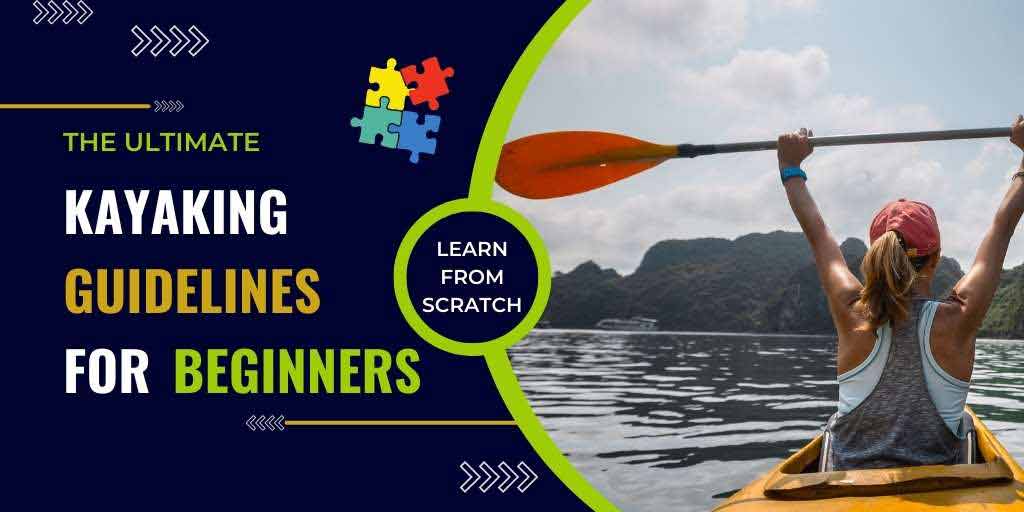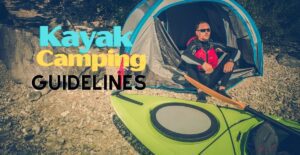Have you ever wanted to try kayaking but weren’t sure where to start? Or maybe you’ve been curious about kayaking but didn’t know what to expect?
Kayaking is a great activity for people of all ages and skill levels. It’s relatively easy to learn, and there’s no need for expensive gear or lessons. All you need is a kayak, a paddle, and a life jacket, and you’re good to go!
In this blog post, we’ll tell you everything you need to know about why kayaking is great for beginners, what you need to get started, and what to expect when kayaking for the first time.
What To Expect When Kayaking For The First Time?
Kayaking is a great activity for beginners, but there are a few things you should know before you hit the water. Here’s what you can expect when you go kayaking for the first time:
You’ll probably get wet: Don’t be surprised if you get wet when you’re kayaking, especially if you’re paddling in waves. It’s part of the fun!
You might tip over: It’s normal to tip over when you’re kayaking, especially when you’re first starting out. Don’t worry; it’s not a big deal. Just climb back into your kayak and keep paddling!
You’ll need some upper body strength: Kayaking is a great workout for your arms and back. If you don’t have much upper body strength, you might get tired quickly. Take breaks as needed, and build up your strength over time.
What You Need to Get Started
To get started kayaking, you’ll need a few things. First, you’ll need a kayak. You can either purchase one or rent one from a local kayaking shop.
Second, you’ll need a paddle. Again, you can either purchase one or rent one from a local shop.
Third, you’ll need a life jacket. This is an absolute must, even if you’re a strong swimmer.

Jump To A Section
Learn The Basics To Get Started With Kayaking
Before you start kayaking, it’s a good idea to familiarize yourself with the basics along with the rules and regulations of this sport. There are several things beginners should know about kayaking before they head out on a long trip.
And it’s always better to learn different techniques than sorry. You should never venture too far from shore, nor push yourself beyond your limits in your beginning days. Kayaking is mostly a solo sport, so you’ll be relying on your wits and common sense!
Here are some of the kayaking basics that you’ll need to learn:
That really depends on how much time you’re willing to put into it.
If you’re just looking to get out on the water and have a bit of fun, then a few hours are all you’ll need. However, if you’re looking to become a competent kayaker, then it will take a bit longer.
Paddling
The most basic thing is paddling technques. To paddle, you’ll need a paddle, of course. You’ll also need a kayak and a life jacket.
Paddling is relatively easy to learn, and once you get the hang of it, it’s quite relaxing.
To paddle, simply dip your paddle into the water on one side of the kayak and then stroke the paddle through the water to the other side. Repeat this stroke on both sides of the kayak to move forward.
Basic Stroke
There are two basic strokes that you need to learn: the forward stroke and the reverse stroke.
Forward Stroke
The forward stroke is the most important stroke, and it’s also the most difficult to master.
To paddle forward, you need to use your arms and your legs. Your arms should be at your sides, and your legs should be extended in front of you.
You should be sitting up straight, and your back should be straight.
Reverse Stroke
The reverse stroke is used to stop the kayak, and it’s also used to turn the kayak around.
To paddle in reverse, you need to use your arms and your legs, but you should be paddling backward.
Start by paddling slowly, and then increase your speed as you get more comfortable. Remember to keep your arms and legs straight and to use your whole body to paddle.
Getting in and out of your kayak
Getting in and out of a kayak can be tricky at first. But with a little practice, you’ll be a pro in no time. Here’s what you need to know:
To get into your kayak, start by sitting on the edge of the cockpit. Then, swing your legs over and into the kayak. Once you’re in, adjust your seating, so you’re comfortable.
To get out of your kayak, first, make sure it’s stable and not going to tip over. Then, swing your legs out of the kayak and onto the ground or dock. Finally, stand up and carefully step out of the kayak.
Turning
To turn your kayak, simply paddle on one side of the kayak more than the other. The kayak will turn in the direction that you paddle more. To turn left, paddle on the right side more. To turn right, paddle on the left side more.
Stopping
To stop your kayak, simply paddle on both sides of the kayak at the same time. This will cause the kayak to stop.
Learn Different Types Of Kayaking
Once you’ve mastered these basic kayaking techniques, you can start to explore the different types of kayaking. There are two main types of kayaking: whitewater kayaking and sea kayaking.
Whitewater Kayaking
Whitewater kayaking is done in rivers or streams. It’s a great way to get away from it all and relax. However, it’s also a great way to get some exercise.
Sea Kayaking
Sea kayaking is done in the ocean. It’s a great way to see the sights and to get some exercise. However, it’s also a great way to get away from it all and relax.
Advanced Kayaking Techniques
Now that you know the basics of kayaking, you’re ready to hit the water and start paddling!
But to get the most out of the adventure, you’ll need to learn some particular techniques too.
Some of the most important advanced kayaking skills include;
Be able to read the water
If you’re new to kayaking, you might not know how important it is to be able to read the water. This skill is essential for all kayakers, but it’s especially important for those who want to kayak in white water. By reading the water, you’ll be able to better navigate your kayak and avoid obstacles.
There are a few things you need to look for when you’re reading the water. The first is the current. You can usually see the current by the way the water is flowing. The second is the depth of the water. You can usually gauge the depth by the color of the water. The deeper the water, the darker it will be.
Another important thing to look for is obstacles in the water. These can be anything from rocks to logs. It’s important to be able to identify these obstacles so you can avoid them.
Once you’ve learned how to read the water, you’ll be able to better navigate your kayak and enjoy your time on the water. So, get out there and start practicing!
Eskimo roll
If you’re new to kayaking, you’ve probably heard of the “Eskimo roll.” It’s a maneuver that allows you to right your kayak if it capsizes, and it’s an essential skill for anyone who wants to paddle safely.
So, what is the Eskimo roll, and why do you need to learn it?
The Eskimo roll is a kayaking technique that allows you to upright your kayak if it capsizes. It’s an essential skill for anyone who wants to paddle safely, and it can be learned relatively easily with some practice.
There are a few different ways to perform an Eskimo roll, but the basic principle is the same: using your body weight and momentum, you roll the kayak over onto its side, then back to upright.
Learning how to control your kayak
Have you ever gone kayaking and felt like you were out of control? Maybe you were paddling too hard, and your kayak began to spin. Or, you were trying to turn, and your kayak just wouldn’t respond.
If this sounds familiar, don’t worry – you’re not alone. Many people feel like they don’t have enough control when they’re kayaking, but the good news is that there are ways to fix this. With a little practice, you can learn how to control your kayak and make it do what you want it to.
One of the most important things to remember when kayaking is that your paddle is your friend. You can use it to help you control your kayak. For example, if you’re paddling too hard and your kayak starts to spin, you can use your paddle to slow it down.
Another way to control your kayak is to use your body weight. If you want to turn your kayak, you can lean your body in the direction you want to go. This will help the kayak turn in the direction you want it to.
Finally, practice makes perfect. The more you kayak, the more comfortable you’ll become with controlling your kayak. Soon, you’ll be able to paddle wherever you want to go and enjoy the ride.
Learn to paddle without getting wet
There’s nothing quite like being out on the water, paddling around, and taking in the scenery. But if you’re new to paddling, it can be a little daunting.
Here are a few tips to help you paddle without getting wet:
Wear the proper attire
This includes closed-toe shoes, a hat, and sunglasses. It is also important to wear a life jacket.
Choose the right kayak
There are different types of kayaks available in the market. It is important to choose the one that suits your needs and abilities.
Sit in the kayak properly
Make sure that you are sitting in the kayak in a comfortable position. Your feet should be in front of you, and your back should be straight.
Hold the paddle correctly
The paddle should be in the middle of your body. Your hands should be in the correct position so that you can paddle efficiently.
Learn to swim back to your kayak
One of the most important kayaking tips is to always swim back to your kayak if you capsize.
Most people who start kayaking don’t think about the possibility of deep water, but it’s important to be prepared for anything. If you find yourself in deep water, the first thing you should do is try to calm yourself down.
It can be very scary to be in deep water, but it’s important to remember that you are a strong swimmer, and you will be able to get back to your kayak.
Once you’ve calmed yourself down, it’s time to start swimming back to your kayak. The best way to do this is to kick your legs and use your arms to propel yourself forward. You may want to practice this before you go kayaking so that you know what to do if you find yourself in deep water.
Once you’ve made it back to your kayak, it’s important to get in as quickly as possible. The sooner you get in, the less chance there is of you capsizing. If you’re having trouble getting in, you can always try to grab onto the side of the kayak and pull yourself in.
Deep water can be scary, but it’s important to remember that you are a strong swimmer, and you can make it back to your kayak. With a little practice, you’ll be able to get back in your kayak and continue enjoying your kayaking adventure.
Learning how to paddle efficiently
There’s nothing quite like being out on the water, surrounded by nature. And, if you’re lucky enough to have a kayak or canoe, you can get even closer to the action. But, before you can enjoy all the benefits of paddling, you need to learn how to do it efficiently.
The good news is that, with a little practice, anyone can learn how to paddle efficiently. Here are a few tips to help you get started:
- Use your body weight to your advantage.
When you’re paddling, your body weight should be evenly distributed between your feet and your hips. This will help you generate more power with each stroke.
- Use your arms, not your shoulders.
Your arms are much stronger than your shoulders, so make sure you’re using them to power your strokes. Keep your elbows close to your body, and use your forearm and upper arm to paddle.
- Keep your strokes short and sweet.
There’s no need to take long, powerful strokes when you’re paddling. In fact, shorter, quicker strokes will actually help you go faster.
- Don’t forget about your legs.
Your legs are a powerful asset when paddling. Use them to help you generate more power and keep your balance.
- Practice, practice, practice.
The best way to learn how to paddle efficiently is to practice. Get out on the water as often as you can, and you’ll soon be paddling like a pro.
Try Flatwater First
When you are just starting out the adventure, you should practice on flat water several times.
A flat-water environment is ideal for beginners kayaking because it is quiet and does not have strong currents. However, you should avoid places with strong currents or tides.
Having a good kayaking experience is essential for enjoying the most out of it. It is not necessary to be an expert kayaker to enjoy the sport. But practice helps you to make the most.
Try teaching yourself by yourself
If you’ve already had a kayaking lesson and aren’t familiar with the basics, try teaching yourself by yourself. While you may be a novice, self-teach yourself is a good way to gain confidence. Practicing with your instructor will help you to learn the basics of kayaking and the different strokes. It is also a good idea to watch for injuries. Having a safety-conscious person will keep you safe while on the water.
Beginners Common Mistakes When Kayaking
Kayaking is easy and a great way to enjoy the outdoors, but beginners often make silly mistakes that even lead to serious injuries. So, it’s always a good idea to know the common kayaking mistakes, and learn to avoid accidents.
Here are some common mistakes beginner kayakers make and how to avoid them;
Paddling Too Hard
One of the most common mistakes beginner kayakers make is paddling too hard. They think that the harder they paddle, the faster they’ll go. But that’s not the case. Paddling too hard will just make you tire yourself out, and you won’t go any faster. The key is to find a balance between paddling hard enough to move forward but not so hard that you wear yourself out.
Not Paddling in a Straight Line
Another common mistake is not paddling in a straight line. When you paddle, your kayak will tend to follow the stroke of your paddle. So, if you’re not paddling in a straight line, your kayak will zigzag back and forth, and you’ll end up going in circles. To paddle in a straight line, keep your eyes on the horizon, and paddle on one side of your kayak.
Not Packing Enough Food and Water
When you’re out on the water, you’ll need food and water to keep your energy up. But many beginner kayakers forget to pack enough, and they end up getting hungry and thirsty. So, before you head out, make sure you have enough food and water for the day.
Not Dressing for the Weather
Another mistake beginner kayakers make is not dressing for the weather. If it’s cold, they don’t dress warmly enough, and if it’s hot, they don’t dress cool enough. Dress in layers so you can adjust to the changing weather conditions. And always pack a raincoat, just in case.
Not Checking the Weather Forecast
Before you head out on your kayaking trip, be sure to check the weather forecast. You don’t want to be caught in a storm out on the water.
Not Wearing a Life Jacket
One of the most important pieces of safety gear for kayakers is a life jacket. But many beginner kayakers don’t wear one, thinking they don’t need it. But if you capsize, a life jacket will keep you afloat until help arrives. So, always wear a life jacket when you’re kayaking.
Not Following the Rules
There are rules for kayaking, just like there are rules for any other activity. Be sure to obey all signs and posted rules, and use common sense when kayaking.
Avoiding these beginner kayak mistakes will help you have a safe and enjoyable trip.
These are just a few of the common mistakes beginner kayakers make. But if you avoid them, you’ll have a much better time out on the water.
Safety Tips For Beginners
Safety is the top priority when kayaking, especially for beginners. Like with any outdoor activity, there are certain safety concerns that need to be taken into account.
For one thing, choose a kayak that fits your level of stability. Wide boats with a large cockpit offer excellent initial stability, meaning that they will be less likely to tip over while you are paddling. You should also make sure that your kayak is secure enough for you to stand on it and not tip over.
Here are some kayaking safety guidelines for beginners to help you stay safe on the water.
Know where to go kayaking in the beginning days
The best paddling location should be protected from the wind, have several landing areas, and be relatively secluded. It should also have minimal boat traffic. Typically, kayakers should paddle in lakes or quiet bays with no currents. Once they’ve gained some experience, they can venture out into heavier terrain.
Learning what to do if you capsize
If you capsize while kayaking, the first thing you should do is stay calm. It can be easy to panic in this situation, but it is important to remember that you are not in danger of drowning if you are wearing a life jacket.
Once you have calmed down, assess the situation. If you are able to get back into your kayak, do so. If not, then stay with your kayak and wait for help.
Remember, when you are in cold water, it is important to try and keep yourself as warm as possible. Huddle close to your kayak and use whatever you have on hand to help insulate yourself from the cold.
Know The Wind Direction
It’s important to remember that the wind is another factor when kayaking. You should always know which direction the wind is flowing in before leaving the shore. This will help you paddle safely and signal for help.
Wear a life jacket
Wearing a properly fitting life jacket is the most important thing you can do to stay safe while kayaking. Make sure to test your life jacket before heading out on the water.
Don’t go alone
It is always best to go kayaking with at least one other person. If something were to happen, having someone else there could mean the difference between life and death.
Be aware of the weather
Before heading out, check the weather forecast and be prepared for conditions on the water. If the weather is bad, it is best to stay on shore.
Know your limits
Don’t push yourself beyond your limits while kayaking. If you are tired, take a break. And, if you are not comfortable with something, don’t do it.
Be prepared
Make sure you have all the necessary safety gear with you before heading out. This includes a life jacket, a whistle, a flashlight, and a first-aid kit.
Follow the rules
There are rules and regulations in place for a reason. Make sure you are familiar with the rules of the area where you will be kayaking.
Stay alert
Be aware of your surroundings at all times while kayaking. This includes other boats, obstacles in the water, and changes in the weather.
Kayaking is one of the most popular outdoor activities and is a great way to enjoy the outdoors, get some exercise, and spend time with family and friends. However, before you can enjoy all that kayaking has to offer, you need to learn the basics from your beginning days.


